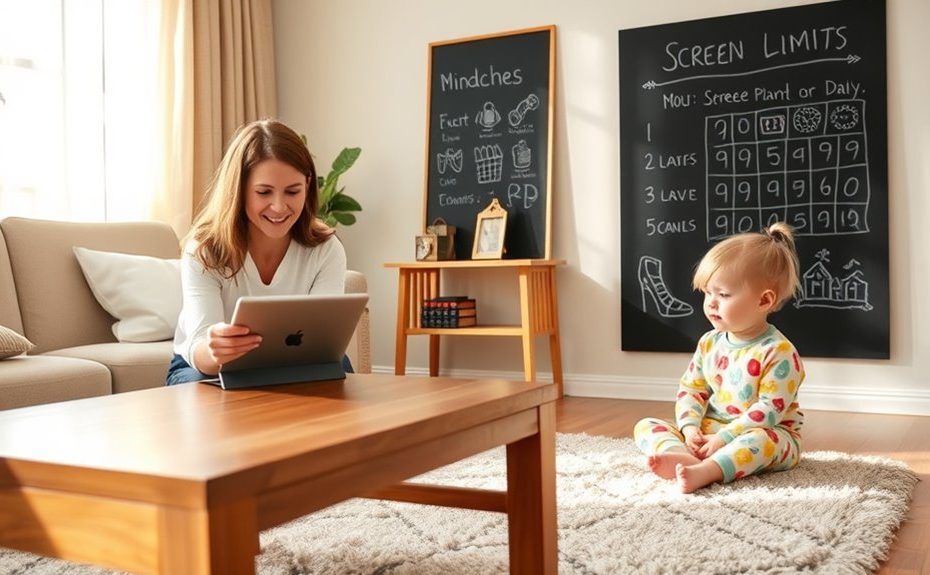To manage your kids’ screen time sanely, establish clear boundaries by setting consistent rules for when and how long they can use devices, and communicate these calmly to reduce conflicts. Incorporate outdoor activities like nature walks or sports as appealing alternatives that promote physical health and creativity. Reinforce routines by designating screen-free times, such as during meals, and create inviting outdoor spaces to encourage more outdoor play. Keep exploring these strategies to find a balanced approach that works for your family.
Key Takeaways
Establish consistent, clear rules for screen time and communicate boundaries calmly to foster cooperation.
Incorporate outdoor activities into daily routines as healthy alternatives to screen use.
Make outdoor spaces inviting with comfortable furniture and engaging features to encourage outdoor play.
Vary outdoor activities and involve children in planning to increase enthusiasm and ownership.
Use outdoor time to reinforce boundaries and promote physical activity, reducing reliance on screens.
Managing your kids’ screen time can feel overwhelming, especially with so many devices vying for their attention. It’s easy to worry about how much time they spend on tablets, smartphones, or game consoles, but establishing clear boundaries can make a big difference. Start by setting consistent rules about when and how long your kids can use screens each day. For example, you might designate specific times for screen use, like after homework or chores are done, and limit it to a certain amount of time. Communicating these boundaries calmly and clearly helps your kids understand expectations and reduces conflicts. Remember, it’s not about completely banning screens but creating a healthy balance. When your children know what’s expected, they’re more likely to cooperate and develop self-control.
Encouraging outdoor activities is another effective way to manage screen time. Kids naturally benefit from fresh air, physical movement, and unstructured play outside. Make outdoor activities appealing by planning engaging outings such as bike rides, nature walks, or visits to the park. When you actively encourage outdoor play, you’re giving your children alternatives to screen time that are fun and enriching. Consider involving them in outdoor chores, sports, or hobbies that require physical effort and creativity. This not only reduces their screen dependence but also fosters a love for nature and physical activity. Plus, outdoor play can improve their mood, boost their health, and enhance social skills when they interact with peers.
Integrating outdoor activities into your daily routine also helps reinforce boundaries around screen time. For instance, you might establish a rule that screens are off during family meals or before bedtime, replacing that time with outdoor play or family conversations. When kids see that outdoor activities are valued and prioritized, they’ll naturally gravitate towards them. To keep things interesting, vary activities and involve your children in planning outings. This sense of ownership makes them more enthusiastic to participate and less likely to crave screens as a default entertainment. Additionally, understanding style choices like outdoor furniture or play equipment can make outdoor spaces more inviting and encourage kids to spend more time outside.
Frequently Asked Questions
How Can I Tell if My Child’s Screen Time Is Excessive?
You can tell if your child’s screen time is excessive by setting boundaries and observing their behaviors. Recognize signs like irritability, trouble sleeping, or neglecting homework and chores. If your child becomes withdrawn or anxious when not on screens, it’s a clear sign. Regularly check in with them about their screen habits, and adjust limits as needed to promote healthier balance and guarantee they’re not overly dependent on screens.
Are There Specific Apps to Monitor or Limit Screen Usage?
Think of your child’s device as a garden needing careful tending. You can use apps like Qustodio, Norton Family, or Family Link for parental control, acting as your digital fence. These apps let you set restrictions, monitor activity, and limit screen time, protecting the garden from overgrowth. With app restrictions in place, you guide their digital journey, ensuring healthy boundaries without stifling curiosity.
How Do I Handle Resistance or Tantrums Over Screen Time Limits?
When your child resists or throws tantrums over screen time limits, use calm behavior management and set clear boundaries. Acknowledge their feelings, stay consistent, and explain why limits matter. Offer alternative activities or breaks to shift their focus. Remember, maintaining your calm helps them feel secure. By sticking to your boundaries and demonstrating patience, you teach respect for rules while easing their frustration.
What Are Healthy Alternatives to Screen-Based Activities?
You can introduce creative indoor activities like arts and crafts, puzzles, or storytelling to keep kids engaged without screens. Encourage family tech-free nights where everyone disconnects and enjoys board games or outdoor play. These alternatives foster imagination and family bonding while reducing screen dependence. By making these activities fun and routine, your kids will naturally turn to healthier, engaging options that support their development and strengthen your family connections.
How Can I Balance Screen Time With Outdoor Play and Homework?
You should establish family routines that prioritize outdoor activities and homework before screen time. Encourage your child to spend time outside daily, whether through walking, playing, or family outings. Set clear limits for screen use and stick to them, making outdoor play a fun and regular part of your routine. This balance helps your child develop healthy habits, improves focus on homework, and nurtures family bonding.
Conclusion
Remember, managing your kids’ screen time is like steering a ship through calm and stormy seas. With steady hands and clear boundaries, you help them navigate safely, avoiding the whirlpools of overuse and digital distraction. Keep the sails of communication open and the anchor of balance firm. When you set the course wisely, you create a safe harbor where your kids can explore, learn, and grow—without losing sight of the real world’s treasures.
